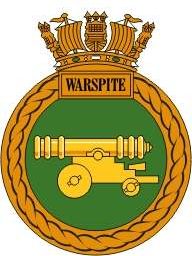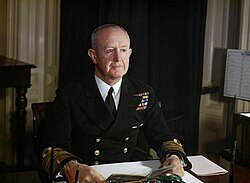Mediterranean (1940–41)
Calabria
Warspite arrived safely in Alexandria before Italy entered the war on 10 June 1940. Admiral Cunningham took the fleet to sea on 7 July to meet two convoys travelling from Malta to Alexandria, knowing that part of the Italian fleet was escorting its own convoy to Tripoli. Cunningham hoped to draw the Regia Marina into battle by sailing towards the “toe” of Italy to cut them off from their base at Taranto.[53] The two fleets eventually met 30 miles from Punta Stilo at the Battle of Calabria on 9 July 1940. Initially the Allied cruisers, armed with 6-inch guns, were outranged by the 8-inch guns of their heavier Italian counterparts and disengaged. Seeing that they were under pressure, Cunningham took Warspite ahead to assist his cruisers. The Italian cruisers turned away under a smoke screen while the battleships Giulio Cesare and Conte di Cavour closed on Warspite before Malaya and Royal Sovereign could catch up. During the battle Warspite achieved one of the longest range gunnery hits from a moving ship to a moving target in history, hitting Giulio Cesare at a range of approximately 24 km (26,000 yd),[54] the other being a shot from Scharnhorst which hit Glorious at approximately the same distance in June 1940.[55] The damage caused by this shell temporarily slowed Giulio Cesare and her destroyers laid a smoke screen. The destroyers and cruisers on both sides continued shooting for half an hour, but with Malaya and Royal Sovereign coming into range the Italian fleet disengaged. Over 125 aircraft of the Regia Aeronautica attacked the ships over the next three hours, but caused no damage.[56] Warspite returned to Alexandria on 13 July.
Taranto
In mid-August she set out to bombard Bardia, and on 6 November she sailed from Alexandria to provide cover for the air strike on Taranto.[57] As a result of this attack Warspite and Valiant were able to attack the Italian supply base in the Adriatic port of Vlorë in mid-December.[58] On 10 January 1941 Warspite was lightly damaged by a single bomb while operating with Force A during Operation Excess.[59]
Matapan
In March 1941, to support the planned German invasion of the Balkans, Vice Admiral Angelo Iachino‘s Italian fleet, led by the battleship Vittorio Veneto, sailed to intercept Allied convoys between Egypt and Greece. Warned of the Italian intentions by intelligence from the Government Code and Cypher School at Bletchley Park,[60] Admiral Cunningham took his fleet to sea on 27 March 1941, flying his flag on Warspite.[61] On 28 March the British cruisers encountered the Italian fleet and were forced to turn away by the heavy guns of Vittorio Veneto. To save his cruisers Cunningham ordered an air strike, prompting Iachino to retreat. Subsequent air attacks damaged the battleship and the cruiser Pola, slowing the former and crippling the latter.[62] Vittorio Veneto escaped to the west as dusk fell, but the British pursued through the night, first detecting Pola on radar and then two of her sister ships.[63] Warspite, Valiant, and Barham closed on the unsuspecting Italian ships and, aided by searchlights, destroyed the heavy cruisers Fiume and Zara, and two destroyers at point blank range.[64] Pola was also sunk once her crew had been taken off.[65] Having established by aerial reconnaissance that the rest of the Italian fleet had escaped Warspite returned to Alexandria on 29 March, surviving air attacks without suffering any casualties.[66]
The Battle of Cape Matapan had a paralysing effect on the Regia Marina, providing the Royal Navy with an opportunity to tighten its grip on the Mediterranean, as evidenced by the unequal battle near the Kerkennah Islands on 16 April.[67] However, this was not enough and the continuing success of the Afrika Korps in North Africa induced Churchill to order a desperate attack on Tripoli to entirely block the Axis supply route by sinking one of the battleships in the harbour.[68] Cunningham rejected this plan, but on 21 April he sailed with Warspite to bombard the harbour in company with Barham and Valiant, the cruiser Gloucester and several destroyers.[69] The raid was ineffectual, partly because of poor visibility created by dust from an earlier RAF bombing raid,[70] but the fleet returned to Alexandria without suffering any damage. The futility of the mission and the exposure of his battleships led to a tense exchange of letters between Cunningham and Churchill.[71]
Crete
During the German invasion of Crete Warspite was used as a floating anti-aircraft battery and,[72] like many other ships, suffered severe damage from German air attacks on 22 May.[73] A 500 lb bomb damaged her starboard 4-inch and 6-inch batteries,[74] ripped open the ship’s side and killed 38 men.[75] The attack was carried out by the Luftwaffe unit Jagdgeschwader 77 (JG 77—Fighter Wing 77). Oberleutnant Kurt Ubben, a future flying ace with 110 enemy aircraft shot down, claimed a hit on the warship.[76] She was able to make it back to port under her own steam, but the damage could not be repaired in Alexandria and it was decided that she would have to be sent to Bremerton on the west coast of the United States.[77]
Repair and refit
In June 1941, Warspite departed Alexandria for the Bremerton Naval Shipyard in the United States, arriving there on 11 August,[28] having travelled through the Suez Canal, across the Indian Ocean to Ceylon, stopping at Manila, then Pearl Harbor and finally Esquimalt along the way.[78] Repairs and modifications began in August, including the replacement of her deteriorated 15 in guns, the addition of more anti-aircraft weapons, improvements to the bridge, and new surface and anti-aircraft radar.[79] Warspite was still at the shipyard when the Japanese Navy attacked Pearl Harbor and went on alert as she would have been one of the few ships in the harbour which could have provided anti-aircraft defence should the Japanese have struck east.[80] She was recommissioned on 28 December and undertook sea trials near Vancouver before sailing down the west coast of the US and Mexico, crossing the equator and arriving in Sydney on 20 February 1942.[81] She joined the Eastern Fleet at Trincomalee in March 1942.[82]



